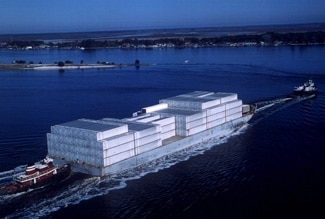
Hubbard Radio Washington DC, LLC. All rights reserved. This website is not intended for users located within the European Economic Area.
Hubbard Radio Washington DC, LLC. All rights reserved. This website is not intended for users located within the European Economic Area.
For the U.S. maritime industry, demand is up and it's dawning on policy-makers it might be time to beef up domestic capacity as China ascends.
Best listening experience is on Chrome, Firefox or Safari. Subscribe to Federal Drive’s daily audio interviews on Apple Podcasts or PodcastOne.
The U.S. maritime industry has a couple of things going for it. Demand is up, and it’s dawning on policy-makers it might be time to beef up domestic capacity as China ascends. It all strengthens the sense of mission of the U.S. Maritime Administration. For an update, Federal Drive with Tom Temin turned to MARAD’s administrator, retired Adm. Mark Buzby.
Interview transcript:
Tom Temin: Admiral Buzby. Good to have you back.
Adm. Buzby: Good morning Tom. Good to be with you.
Tom Temin: Let’s start with the Maritime Academy itself, given the current crisis. And that’s a place I have a feeling you sort of dote on like a mother hen. How are things there? And what’s the status?
Adm. Buzby: Yeah thanks Tom. Yes, I do pay a lot of attention to King’s Point, as I do with the other Maritime Academies, but particularly with King’s Point, my alma mater. Yeah, since spring break, we have kept all of the mid shipment at home since about mid March. You know, we saw the looming concern coming with the coronavirus and just could not ensure their safety by bringing him back to campus there in Kings Point, New York. So they are all at home. We made the very rapid decision to basically shift all of our curriculum to distance learning. And none of it was before and, you know, hats off to Dean John Ballard and all his faculty, who in the course of about four days basically converted all of the curriculum to a distance learning format on and began teaching it as I said two weeks ago. Second week they’ve been doing, and it’s been very, very effective. Students enjoy it. They like it and it’s delivering the curriculum in a very, very good way.
Tom Temin: And how about things at headquarters? I believe you’re in the transportation building in D.C.
Adm. Buzby: That’s affirmative. We are basically at max telework. There are very, very, very few people in the building. I come in a day or two a week just to take care of odds and ends that need my signature or something like that. But for the most part, all of the MARAD headquarters staff is teleworking. Our field activities around the country are in max telework. There are some of our fleet sites that require people to be on site for security and care of the vessels maintenance they’re showing up, but they’re all adhering to social distancing and on all the CDC guidelines to ensure their safety as well.
Tom Temin: Yeah, The sad thing is from that building there was no place to sneak out and see opening day the other day.
Adm. Buzby: Unfortunately not. I never thought that I’d ever missed a lot of traffic. But I did miss it.
Tom Temin: And let’s talk about the national security multi mission vessels. This is kind of a long term project. Can you give us an update on it?
Adm. Buzby: Were tantalizingly close to signing the contract, or to have our vessel construction manager more accurately sign a contract with a shipyard to begin construction of the first ship. We plan on a five ship program to replace five of the six large school ships for our state maritime academies. So as I said, we’re probably within a week or so of having that that shipyard announced. Then we’ll begin the process for building brand new from the keel up first time in our nation’s history training vessel that also does double duty as a vessel that can help in humanitarian assistance missions, for post hurricane or other sorts of missions like that. So we’re excited to get that going on. Hopefully we’ll have that news to be announced.
Tom Temin: And I wanted to ask you about the CSBA study, a massive study done on the maritime industry of the United States. And what’s your assessment of the current relationship between MARAD and the commercial shipping industry of the United States and MARAD’s own capacity in time of perhaps national need?
Adm. Buzby: You know, by statute, we’re there to foster and promote strong merchant marine and maritime transportation systems. So we maintain a very close relationship with all aspects of our merchant marine, both domestic Jones Act fleet and our internationally trading fleet. We oversee a maritime security program that ensures that we have assured access to U.S. tonnage in time of crisis or need to move our armed forces, because that’s how we move them is on commercial vessels. So we’re very closely aligned with them. The CSBA study that talked about strengthening the U.S. defense Maritime Industrial Base which also has applicability to our commercial shipbuilding base, I think was a really, really good study. Was an important spotlight to put on the state of, the poor state of American shipbuilding capacity that is really kind of been decreased over the years. Such that basically it really now just supports government shipbuilding for Navy, Coast Guard and NOAA for a few ships, and repair on building of Jones Act ships, you know, domestic that are required by the Jones Act to be built in U.S. yards way. We just do not build internationally trading ships anymore in this country, which is a shame. So we watch it very keenly and are always looking for opportunities to try and strengthen that that industry to keep it going.
Tom Temin: Because at the same time, MARAD’s own fleet keeps getting older and older, and the state of readiness of it is sometimes a question. And I guess my question is, what is the status of it right now? And should MARAD simply go to 100% reliance on commercial fleet and maybe not have that albatross of its own fleet?
Adm. Buzby: Yeah, that’s a good point, that’s being debated quite a bit. You know, we manage the Ready Reserve Force, which is a fleet of 46 aged ships, average age of 45 years old. But these are ships that are militarily useful and so they have roll on roll off capacity for the most part, ramps that sort of thing, that can move rolling stock and other material for the military as required in supportive combatant commander requirements. So these are ships that kept primarily in five day readiness spread around the Gulf Coast, East Coast, West Coast to give us a very rapid surge capacity because of their age. Some of the readiness of those ships is suffering. We typically are in the 70 percentile range in terms of readiness for those ships. We’d like to be up closer to about 85. We exercise these ships from time to time, and we are finding that they are becoming more difficult and more expensive to maintain. So the idea of getting newer ships and maybe shifting that burden to the commercial merchant marine has some attractiveness to it. But we have to have that access. We have to be able to get our hands on those ships and move them to load out ports very rapidly, and you can’t always count on that with commercial ships that might be trading somewhere else in the world.
Tom Temin: Sure, and so is there much appetite on Capitol Hill for addressing that issue?
Adm. Buzby: Absolutely, We’ve we’ve seen, particularly in the House Armed Services Committee. Chairman Courtney and ranking member Wittman and chairman of Readiness Committee Garamendi have all been very, very focused and active on helping us and the Navy figure out how to best recapitalize the ready reserve force going forward Whether we just repopulate the same model that we’re using now, or whether we shift to a different mix of ships, more commercial, less government or whatever to figure out how to have the best ensure our readiness going forward. So lots of discussions going on right now about that.
Tom Temin: But fundamentally, it seems like there is pretty wide based support for continuance of the Jones Act provisions. That is to say, we wouldn’t increase the capacity by buying ships made in China, for example.
Adm. Buzby: That would be, you know, we would prefer to use us built ships. The stark reality of it, though, is that there just are not the types and numbers of U.S. built cargo ships available to us to put into that ready reserve program unless we built them new. And that’s part of the equation as well, to have a building program where we would build in U.S. shipyards sea lift ships or ships that could be used in time of crisis and to provide national sea lift. Absent that, we are going to be forced to reach out to the commercial merchant marine and use some foreign built ships to re populate our ready reserve force. We are not going to have a much of choice in that,
Tom Temin: Retired Admiral Mark Buzby is the Maritime administrator. Thanks so much for joining me.
Adm. Buzby: My pleasure Tom. Good to be with you.
Copyright © 2024 Federal News Network. All rights reserved. This website is not intended for users located within the European Economic Area.

